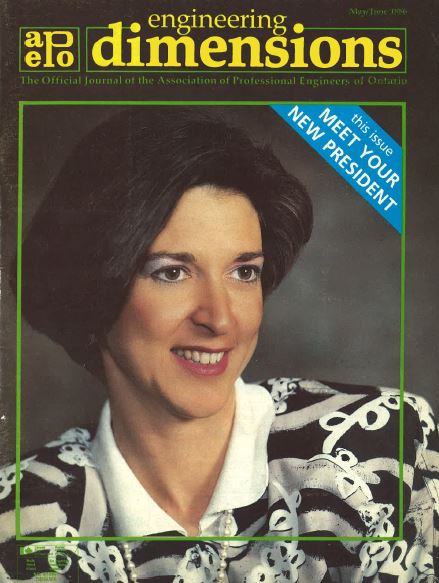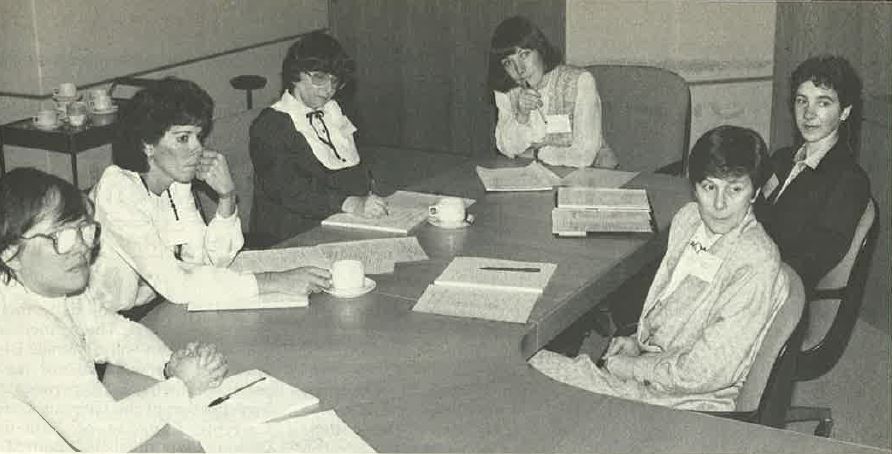Claudette MacKay-Lassonde and a History of Women in Engineering in Canada
—
The following blog post was prepared by Valerie Davidson, P.Eng., former OSPE Board Director, past Chair and current member of OSPE’s Women in Engineering Advocacy Champions Task Force (WE ACT), and Board Member of the Canadian Engineering Memorial Foundation (CEMF).
October is Women’s History Month in Canada and this year’s theme, #MakeAnImpact, focuses on women trailblazers who have driven lasting change as pioneers in their field. It is a fitting time to remember Claudette MacKay-Lassonde, who was an influential trailblazer for women in engineering in Canada.
Claudette was passionate about improving the professional and educational environment for women in engineering. As she advanced to senior levels in her engineering career, she worked to remove barriers so that “those [women] who aspire to reach the top of the profession should be given a fair shot.”
Trailblazers in the 1970s and 80s:
—
Historian Ruby Heap considers the women who studied engineering in Canadian universities during this time period as pioneers. “Before the 1970s, the majority of female engineers in Canada had studied engineering before emigrating to Canada, mainly from Eastern Europe.”[i] Claudette finished an undergraduate degree in chemical engineering in 1971 – one of ten women in the entire graduating class at École Polytechnique.
On a personal note, I was just starting first year engineering at McMaster in 1971. My graduation in 1975 coincided with the International Women’s Year. Women were challenging male norms and demanding equal opportunities, but the needle was moving very slowly in terms of the number of women who were graduating from engineering.
According to early records of the Canadian Accreditation Board, 3% of engineering degrees in Canada were granted to women in 1975. By the end of the 1980s, this percentage barely reached double digits (13%). So over these two decades, the number of women entering the engineering profession grew incredibly slowly. And these women tended to be very isolated when they entered work force, started families and took maternity leaves.

WISE Canada:
—
Claudette MacKay-Lassonde went on to complete a master’s degree in nuclear engineering in 1973 at the University of Utah and then started her professional career at Bechtel Corporation in San Francisco. It was through her professional experience in the US, that she became familiar with the American Society of Women Engineers (SWE) – an organization that included both student and professional members. SWE had local chapters across the US and offered national-scale conferences on an annual basis. Claudette recognized the value of an association for women in the STEM fields. When she returned to Canada, she founded Women in Science and Engineering/Femmes en Science and Ingénierie (WISE) in 1977. The national headquarters for WISE was based in Toronto, and local chapters formed in Ottawa, Sarnia, Kingston, Montreal, Newfoundland and New Brunswick throughout the following decade.
Claudette was responsible for organizing the first WISE conference in Canada in 1981. At the time, I was a graduate student at the University of Toronto. Although about 20% of the undergraduates in chemical engineering were women, there were very few women in doctoral programs in engineering. I had the pleasure of attending the conference, and what stands out vividly in my memory was the incredible feeling of being with so many women – trailblazers, participants and speakers – talking openly about the challenges of working in male-dominated workplaces. It was so different from my academic or work experience up to that point.
Claudette was one of the keynote speakers and she spoke passionately about the need for women engineers to join organizations that offered mutual support, invoking the frustration she herself had felt while breaking into the field: “Unless you’ve lived it, you don’t understand how hard it is,” she confessed and then explained how “every time a woman reaches a level that hasn’t been broken by others, she faces resistance, and men will be mean.”[ii]
The Formation of WEAC:
—
In the early 1980s, Claudette started taking on leadership roles with the Association of Professional Engineers Ontario – now known as Professional Engineers Ontario (PEO) – first as a member of Council and then as the first woman to serve as President in 1986.
As President Elect, she initiated and chaired the first APEO think tank, “Women in Engineering – Gaining Perspective.” Her purpose was to gain a broader perspective on the challenges that women in engineering face. The think tank formed a Task Force on Women in Engineering that made a number of recommendations to Council, including a proposal for a standing committee called the Women in Engineering Advisory Committee (WEAC).

WEAC was approved by Council in 1988, and in 2003 the committee was moved to OSPE. It was renamed the Women in Engineering Advocacy Champions Task Force (WE ACT) in Feb. 2018.
A Time of Triumph and Tragedy
—
The late 1980s were marked by positive steps forward for women in engineering, however, tragedy also struck the engineering community during this period. At that time, Claudette MacKay-Lassonde held a senior position at Northern Telecom and she was instrumental in developing the first academic Chair for Women in Science and Engineering – the NSERC/Northern Telecom Chair at the University of New Brunswick. Dr. Monique Frize, P.Eng., began her term as the first chair-holder by attending the funeral service for the women who lost their lives at École Polytechnique in December 1989.
In response to the tragedy at École Polytechnique, Claudette spearheaded the formation of the Canadian Engineering Memorial Foundation (CEMF) and successfully raised funds for scholarships. The CEMF continues to raise funds to provide scholarships for female students in accredited undergraduate and graduate engineering programs across Canada.
A True Trailblazer and Change Agent
—
The aforementioned examples highlight some of the many ways that Claudette MacKay-Lassonde brought change to the engineering profession in Canada. I was fortunate enough to witness some of these efforts directly, and although I didn’t know her well, I had great respect for her leadership and her ability to get results.
I think that Claudette was an effective change agent due to her passion to see more women in the profession and her success in the corporate world. She worked to engage senior decision-makers and produce practical solutions. But she also spoke directly and honestly to women in the community about the challenges of work-life balance.
In her final column in Engineering Dimensions as President of APEO, she said that, “The past 12 months have brought me a great deal of personal satisfaction, but I must confess that I am looking forward to a less hectic schedule and some needed time with my husband and my children Julie and Christian.” In 1996, Claudette spoke at the University of Toronto and again offered this practical advice about the importance of balance in one’s career. “You have to decide what is important to you, accept the costs and go after it. Realize that you can’t have it all. But you can have what you value most.”[iii]
Claudette Mac-Kay Lassonde died in 2000 after a long battle with cancer. In recognition of her many contributions, the Women in Engineering Advisory Committee (now WE ACT) named its annual fall forum in her honour.
______________________________________________
[i] R. Heap, “Fighting the “Corset of Victorian Prejudice” Women’s Activism in Engineering during the Pioneering Decades (1970s – 80s), Chap. 11 in Feminist History in Canada: New Essays on Women, Gender, Work and Nation, p. 222.
[ii] ibid p. 224
[iii] S. Kneisel, 2000. “Pioneer for Women”, Canadian Consulting Engineer, accessed at www.canadianconsultingengineer.com/features/pioneer-for-women/ on September 21, 2018.






Leave a Comment